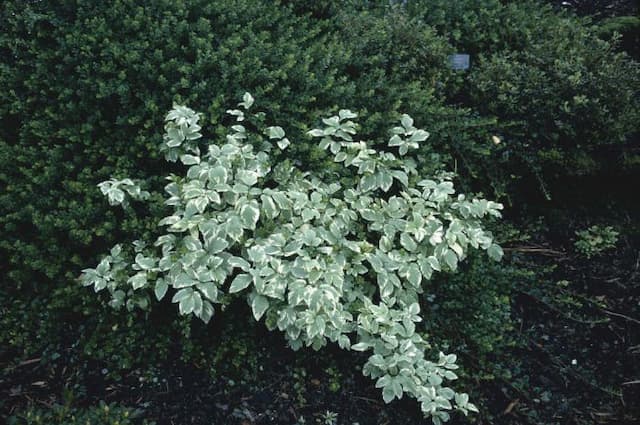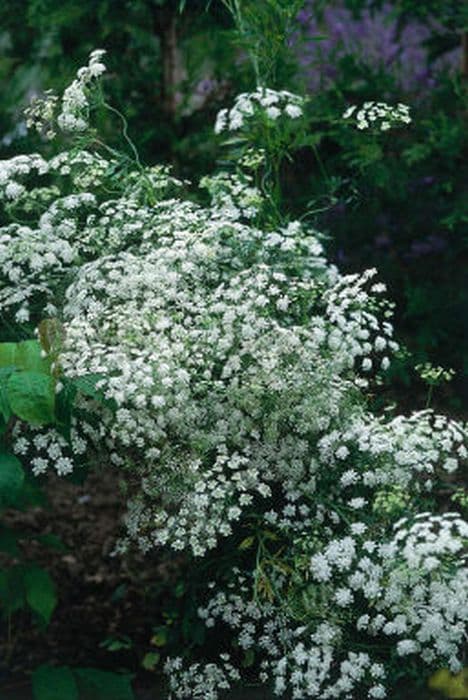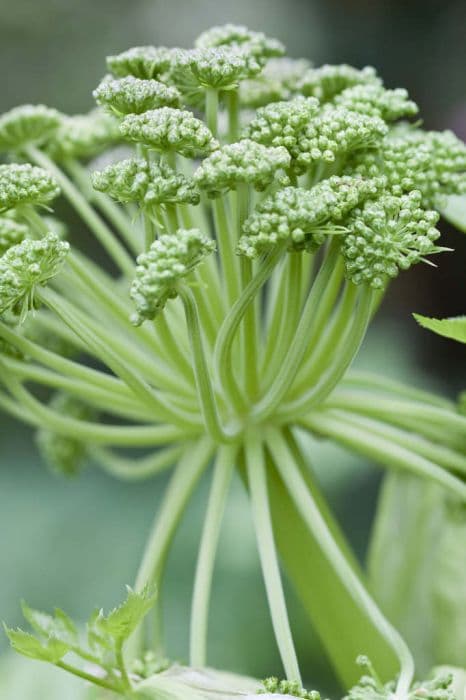Sea Holly Eryngium bourgatii 'Picos Blue' (PBR)

ABOUT
The Eryngium bourgatii 'Picos Blue', commonly known as Sea Holly, is a striking perennial plant known for its ornamental value in the garden. Its aesthetic is defined by a blend of spiky texture and unique coloration. The leaves are a deep green, often with a hint of bluish or silver tinge, and they are intricately veined, adding to the fine texture of the plant. These leaves form a rosette at the base, with smaller leaves clasping the stems further up. The Sea Holly is especially admired for its flowers which are a metallic blue or violet color, creating an eye-catching display that seems almost iridescent in the sun. These blossoms are tightly clustered into cone-like heads that are surrounded by a spiky ruff of bracts, which are modified leaves that take on a similar silvery-blue hue. The striking color of the flowers and bracts often makes this plant a focal point in gardens, drawing attention with its bold, yet somewhat alien appearance. These colorful flower heads sit atop stiff, branched stems that rise above the foliage. The overall impression of the Eryngium bourgatii 'Picos Blue' is one of strong architectural form and a touch of the exotic, combined with a color palette that cools the landscape, making it a sought-after plant for gardeners looking to add a touch of drama and contrast to their planting schemes. It's also a popular choice for dried flower arrangements due to the robust, lasting quality of its blooms.
About this plant
 Names
NamesFamily
Apiaceae
Synonyms
Picos Blue Sea Holly, Bourgat's Sea Holly, Mediterranean Sea Holly
Common names
Eryngium bourgatii 'Picos Blue' (PBR)
 Toxicity
ToxicityTo humans
Sea Holly is not commonly listed as a toxic plant to humans. Therefore, ingesting it is not expected to cause significant symptoms of poisoning. However, as with any plant not designated for consumption, it is still advisable to avoid eating it since individual reactions can vary, and it may cause minor stomach discomfort or an allergic reaction in sensitive individuals.
To pets
Sea Holly is not commonly known to be toxic to pets. It is not listed as a poisonous plant for cats, dogs, or other domestic animals. However, if a pet were to ingest a part of the plant, they might experience mild gastrointestinal upset, such as vomiting or diarrhea, simply from eating something that isn't part of their normal diet. If any adverse effects are observed, it is recommended to consult a veterinarian.
 Characteristics
CharacteristicsLife cycle
Perennials
Foliage type
Evergreen
Color of leaves
Green
Flower color
Blue
Height
2 feet (60 cm)
Spread
1 foot (30 cm)
Plant type
Herb
Hardiness zones
5
Native area
Mediterranean
Benefits
 General Benefits
General Benefits- Attractive Foliage: Eryngium bourgatii 'Picos Blue' features striking blue-tinged foliage that adds a unique color contrast to garden beds.
- Drought Resistance: Once established, this plant has a good tolerance to drought conditions, making it suitable for xeriscaping.
- Low Maintenance: It requires minimal care once established, making it ideal for gardeners looking for easy-care options.
- Attracts Wildlife: The flowers of Sea Holly attract bees, butterflies, and other beneficial insects to the garden.
- Architectural Interest: The plant provides strong structural interest with its spiky texture and form, which can enhance the visual appeal of a garden.
- Long-Lasting Blooms: The vivid blue flowers last for an extended period from summer to early fall, providing long-lasting color in the landscape.
- Good Cut Flowers: The flowers and stems are excellent for cutting and using in fresh or dried floral arrangements.
- Rabbit Resistant: Sea Holly is generally resistant to rabbits, which is beneficial for gardeners in areas with high rabbit populations.
- Salt Tolerant: It can tolerate salt spray, making it a good choice for coastal gardens.
 Medical Properties
Medical Properties- This plant is not used for medical purposes.
 Air-purifying Qualities
Air-purifying QualitiesThis plant is not specifically known for air purifying qualities.
 Other Uses
Other Uses- Eryngium bourgatii 'Picos Blue', commonly known as Sea Holly, can be used in floral arrangements, both fresh and dried, due to its unique texture and color that adds a modern touch.
- Sea Holly can be incorporated into themed gardens, such as xeriscape or coastal gardens, because it's drought-tolerant and its silvery-blue hue complements such landscapes.
- The thistle-like appearance of Sea Holly can be utilized as an educational tool to teach about plant defenses, as its spiny leaves deter herbivores from eating it.
- In garden design, Sea Holly can create dramatic contrasts when paired with soft, billowy plants, providing an architectural element to the garden structure.
- As a cut flower, Sea Holly can be dipped in metallic paint or glitter for decorative purposes to create ornaments or embellishments for festive occasions.
- The strong stems and spiky form of Sea Holly allow it to be used in natural pest control strategies, deterring small animals and insects from more vulnerable plants in a garden.
- Sea Holly can be used in crafting, for example, in creating wreaths and other decorative items where its unique shape and color provide an attractive focal point.
- The plant can be used in habitat gardens to attract pollinators like bees and butterflies, thus playing a role in supporting local ecosystems.
- Its roots can be used in perfumery as a fixative to extend the durability of fragrances, although this is not a common practice today.
- Sea Holly could be used as a natural dye source, where different parts of the plant can yield various shades of blue and green for textiles or art projects.
Interesting Facts
 Feng Shui
Feng ShuiSea Holly is not used in Feng Shui practice.
 Zodiac Sign Compitability
Zodiac Sign CompitabilitySea Holly is not used in astrology practice.
 Plant Symbolism
Plant Symbolism- Persistence: Eryngium bourgatii, commonly known as Sea Holly, has spiny leaves and a tough nature, symbolizing resilience and an ability to thrive in difficult conditions.
- Independence: Sea Holly's unique appearance and growth in harsh environments convey a message of self-reliance and autonomy.
- Attraction: With its striking blue color, the Sea Holly stands out, representing an allure or magnetism that can draw attention in an understated yet powerful way.
- Protection: The prickly texture of the Sea Holly's leaves and bracts can suggest a protective quality, much like a barrier or shield against adversity.
 Water
WaterSea Holly should be watered deeply but infrequently, allowing the soil to dry out between waterings. During the growing season, a good rule is to water every 7 to 10 days, providing about 1 inch of water each time. Less water is needed during the dormant season in winter. It's important to avoid overwatering, as this plant is drought tolerant and prefers well-drained soil. Water at the base of the plant to minimize moisture on the leaves and prevent fungal diseases.
 Light
LightSea Holly thrives in full sun conditions where it can receive at least 6 hours of direct sunlight daily. It is best positioned in a spot that has clear exposure to sunlight with little to no shade, as ample sunlight is essential for the plant's development and for maintaining the vibrancy of its blue flowers.
 Temperature
TemperatureSea Holly is a hardy plant that can tolerate a wide range of temperatures, from as low as 0 degrees Fahrenheit in winter to temperatures exceeding 85 degrees Fahrenheit in summer. However, it thrives best in temperatures between 60 and 70 degrees Fahrenheit. Ensuring it is planted in a location that doesn’t experience prolonged extreme temperatures will contribute to its overall health and flowering.
 Pruning
PruningSea Holly should be pruned to remove spent flowers and to shape the plant, which encourages new growth and a tidy appearance. Pruning is best done in late winter or early spring before new growth begins. Deadheading the spent blooms during the growing season can also promote additional flowering. Pruning is not only cosmetic but can also assist in controlling the size and spread of the plant.
 Cleaning
CleaningNot needed
 Soil
SoilSea Holly thrives in well-draining soil with a mix of sand, loam, and a little organic matter to ensure good drainage. The ideal pH for Sea Holly is between 6.0 and 7.5. A lean soil will encourage more intense blue coloration in the 'Picos Blue' flowers.
 Repotting
RepottingSea Holly does not need frequent repotting and prefers to be left undisturbed. Repot only every 3-4 years or when the plant outgrows its current container. Doing so in early spring is considered optimal.
 Humidity & Misting
Humidity & MistingSea Holly is tolerant of a range of humidity levels and does well in dry to average household humidity. It does not require high humidity environments and is quite drought-tolerant once established.
 Suitable locations
Suitable locationsIndoor
Place Sea Holly in bright, indirect light with good air flow.
Outdoor
Plant in full sun, in well-draining soil, spacing 12 inches apart.
Hardiness zone
5-9 USDA
 Life cycle
Life cycleEryngium bourgatii 'Picos Blue', commonly known as sea holly, begins its life cycle as a seed, which, when sown in well-draining soil and exposed to sunlight, germinates to produce small seedlings. These seedlings grow into rosettes of spiky leaves, and as the plant matures, it develops sturdy stems and a deep root system that can tap into water reserves during dry periods. During its flowering stage, usually in the second year and summer months, Eryngium bourgatii 'Picos Blue' produces striking blue or steel-colored flower heads that are highly attractive to pollinators such as bees and butterflies. After pollination, the flowers develop into seeds, completing the reproductive cycle. The plant is perennial, surviving winters to regrow the following spring from its root system before eventually becoming senescent and dying after several years. Proper care throughout its life, including full sun exposure and avoidance of wet soils, ensures a healthier and more prolonged life span for this ornamental plant.
 Propogation
PropogationPropogation time
Spring to Summer
Propogation: Eryngium bourgatii 'Picos Blue', commonly known as Sea Holly, is typically propagated through seed. The best time to propagate Sea Holly by seeds is either in fall or late winter into early spring. To do this, seeds should be sown in a well-drained soil mix, barely covered with soil, and kept moist. They require a period of cold stratification to germinate, so if sowing is done indoors in late winter, the seeds may be refrigerated for a few weeks before planting. It is also essential to provide sufficient light once the seeds are sown to facilitate proper germination. Germination can be slow and erratic, so patience is necessary when propagating Sea Holly from seed. Once seedlings have grown sturdy enough, they can be transplanted to their final position in the garden, taking care to space them approximately 12 inches (about 30 centimeters) apart to allow for their full growth and spread.









